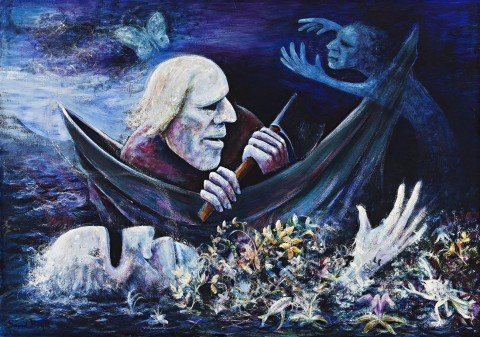TRUGANINI – THE DROWNING OF HER BETROTHED, 1959
DAVID BOYD
oil on composition board
120.0 x 173.0 cm
signed lower left: David Boyd
Victorian Artists’ Society, Melbourne
Paul Morawetz, Victoria
Frederick William Olver, Melbourne
Thence by descent
Keith Frederick Olver, Melbourne
Thence by descent
Private collection, Melbourne
Antipodeans, Victorian Artists’ Society, Melbourne, 4 – 15 August 1959, cat. 21
David Boyd: A Retrospective, The Commonwealth Institute Art Gallery, London, 18 April – 11 May 1969; touring to Commonwealth Institute Art Gallery, Scotland, 22 May – 7 June 1969; and City Art Gallery, Sheffield, 19 July-17 August 1969, cat. 13 (as ‘Her betrothed drowned’) (label attached verso)
The Antipodeans: Another Chapter, Lauraine Diggins Fine Art, Melbourne, 17 October – 4 November 1988; Nolan Gallery, Lanyon, Australian Capital Territory, 12 November 1988 – 8 January 1989; S.H. Ervin Gallery, Sydney, 21 January – 26 February 1989 (as ‘Her Betrothed Drowning’) (label attached verso)
Blackman, B., ‘The Antipodean Affair’, Art and Australia, Ure Smith, Sydney, vol. 5, no. 4, March 1968, p. 613 (illus. as ‘The drowning of her betrothed’)
Daily Telegraph, London, 31 May 1968, unpaginated (illus.)
David Boyd: A Retrospective, The Commonwealth Institute Art Gallery, London, 1969, cat. 13 (illus. as ‘Her betrothed drowned’)
Benko, N., The Art of David Boyd, Lidums, Adelaide, 1973, pp. 32, 35 (illus. as ‘Her betrothed drowned’
Truganini – Dream of Childhood, 1958 – 59, oil on composition board, 181.5 x 119.5 cm, in the collection of the National Gallery of Australia, Canberra
In 1959, a group of seven Australian artists and one historian joined under the collective name of ‘Antipodeans’. Although they only held one exhibition together, it was an outstanding financial success, but it also attracted its fair share of hostility, not least for the inclusion of David Boyd’s raw, uncompromising paintings which confronted the atrocities committed by settlers against the indigenous Tasmanians. One of these was Truganini – The Drowning of her Betrothed, 1959, an integral example from the five-painting cycle based around the brutal humiliations suffered by the young Truganini (Lalla Rookh). With hindsight, these are now recognised as historically important images, marking the first time an Australian artist dared to depict this dark chapter of Australian history and show it specifically to non-Indigenous eyes.1
David Boyd was born into an illustrious artistic family whose members were raised to be ethical and committed humanists. After the Second World War, Boyd studied at the National Gallery School, and held exhibitions of his paintings with fellow student John Yule in 1945 and 1946. With his wife Hermia, he moved to London in 1951 where the couple’s ceramic work soon attracted positive attention, which continued after their return to Melbourne in 1954. Boyd re-engaged with painting in the late 1950s producing a blunt suite of paintings based on Australian explorers, men usually depicted by artists as tragic heroes. In Boyd’s hands, they were otherwise exposed for their guile, ignorance and blatant racism.
Through discussions with his colleague Clifton Pugh and later, the art historian Bernard Smith, Boyd started gathering a group together who were all interested in pursuing figurative art over abstraction.2 Called the ‘Antipodeans’, their ideals covered a wide spectrum of topics including ‘political issues such as Aboriginal rights and the abolition of the White Australia policy … (believing) the artist’s role was to ask questions about the society in which he lived’.3 Held at the Victorian Artists’ Society in Melbourne, the exhibition witnessed ‘a mighty impressive opening. The gallery had never seen such crowds’.4 Unfortunately, the younger Boyd received negative commentary from ill-informed critics convinced he was simply grabbing onto the shirttails of his more prominent brother Arthur. In fact, David had been singularly appalled by all he’d read on the plight of Tasmania’s Aboriginal people; in Truganini – The Drowning of her Betrothed, for example, the young girl witnesses the mutilation and drowning of her fiancé by timber-getters as she is dragged off into sexual slavery. Above the sculptural cast of the faces, a small butterfly hovers, a spirit form of her ancestors. It is one small ray of hope amongst the madness. Returning to London on a Travelling Scholarship in 1960, Boyd subsequently enjoyed a successful decade as a painter culminating in a prestigious retrospective held at the Commonwealth Institute of Art. Here, the tables were turned with critics falling over each other to praise uncompromising works such as Truganini – The Drowning of her Betrothed, with the Sunday Telegraph proclaiming that the artist was ‘among the very best painters at work in this country, and certainly the most powerful image maker’.5 For David Boyd, this must have been sweet vindication.
1. There is one precedent, a solitary painting by Sidney Nolan (Aboriginal hunt, 1947) which is conversely dreamlike in its depiction of a person being forced off a cliff.
2. Also included were John Brack, Robert Dickerson, Charles Blackman, John Perceval and Arthur Boyd.
3. Haycroft, D., ‘The Making of a Manifesto’, Art and Australia, Fine Arts Press, Sydney, vol. 26, no. 2, Summer 1988, p. 285
4. David Boyd, quoted in Blackman, B., ‘The Antipodean Affair’, Art and Australia, Ure Smith, Sydney, vol. 5, no. 4, March 1968, p.611
5. Mullins, E., ‘Vuillard under the lamp’, Sunday Telegraph, London, 4 May 1969
ANDREW GAYNOR
